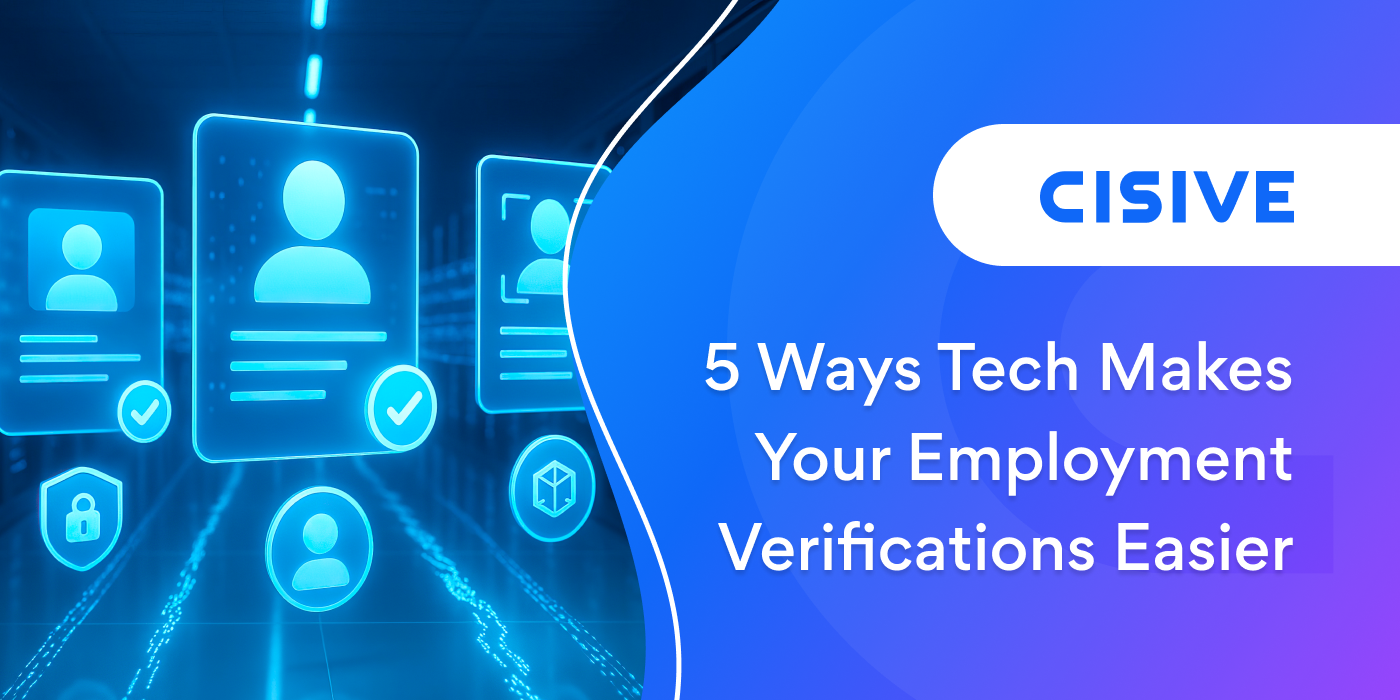
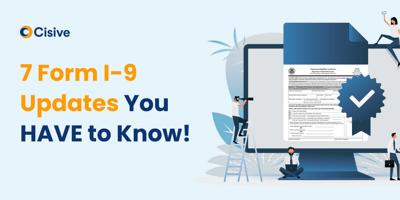
U.S. employers use Form I-9 for employment eligibility verification when hiring. That’s why you...

Employment verifications are an essential part of the hiring process. They help employers hire only the most qualified candidates and minimize legal and compliance concerns.
However, this process can be time-consuming and difficult, particularly when candidates have extensive job histories. Employers increasingly use technology to make employment verifications easier.
Let’s explore the benefits of accurate background employment verification and the historical challenges of verification. You’ll also learn how technology simplifies the process and the role of the Velocity Network Foundation aka blockchain.
Key Takeaways
|
Employment verification is an essential part of the hiring process. It’s when human resources professionals and hiring managers examine a prospective employee’s work history for accuracy and potentially disqualifying findings.
An estimated 95% of employers have documented screening policies for background checks, which often include employment verification.
These policies include steps such as contacting previous employers about dates of employment, job titles, eligibility for rehire, and reasons for leaving.
Employment verification can be part of a comprehensive background check process that confirms and detects additional facts. These include the applicant’s name, address, date of birth, Social Security number, legal work status, criminal record, and educational credentials.
Employment verification helps organizations make informed hiring decisions with confidence about the candidate’s declared information. By verifying prior and current employment, you can confirm that new hires have the relevant experience and skills.
Employment verification also allows you to identify candidates with a history of workplace misconduct or other legal issues. This is especially important in highly regulated industries or job roles where employees have access to finances or sensitive data.
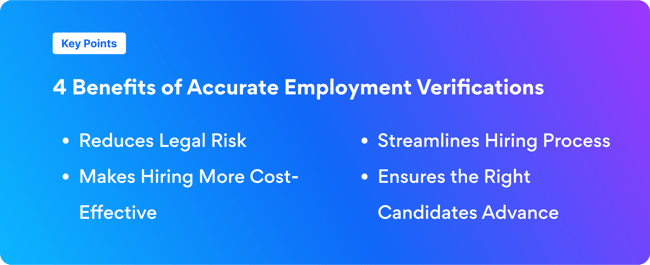
Verifying employment history helps you make informed hiring decisions and bolsters the reputation of your talent acquisition team.
Here are the top four benefits of employment verification in the hiring process.
Accurate background employment verification results protect businesses from potential legal risks and poor outcomes. These include hiring candidates who lack the required credentials, submit false information, or can’t legally work in the jurisdiction.
Additionally, employment verification helps employers comply with various legal and regulatory requirements.
Certain industries, such as healthcare, have specific licensing or certification prerequisites. A doctor operating without a license to practice medicine in your state, for instance, could result in dire consequences for patients and your institution.
Reduce time to fill when your employment verification processes are standardized and leverage technology when possible. Background employment verification technology reduces turnaround time while confirming relevant information about a candidate’s employment history and other relevant criteria.
At Cisive, we combine our extensive background screening knowledge and experience with state-of-the-art technology to streamline the hiring process by offering faster, more accurate employment verification results.
By quickly getting accurate information and moving forward with vetted candidates, employers reduce the need for time-consuming, manual background checks.
Accurate background employment verification helps employers confirm that candidates have the qualifications they need to succeed in a given role. By rigorously assessing a candidate’s work experience and qualifications, you can secure a finalist pool of vetted candidates.
Verification processes allow employers to identify discrepancies between what candidates claim they can do and what they can actually do. This improves hiring quality and makes sure you don’t accidentally overlook qualified candidates.
Accurate background employment verification is a cost-effective way for employers to make informed hiring decisions.
By verifying applicants’ information, employers avoid wasting time and money on unqualified candidates. Employers also experience less turnover caused by poor hiring decisions, further saving on recruiting and onboarding costs.
Additionally, employment verification can minimize the potential for legal issues related to negligent hiring. Organizations that thoroughly vet candidates are less likely to hire people who jeopardize workplace safety or engage in misconduct.
Quality hires also reduce the risk of costly legal battles and reputational damage.
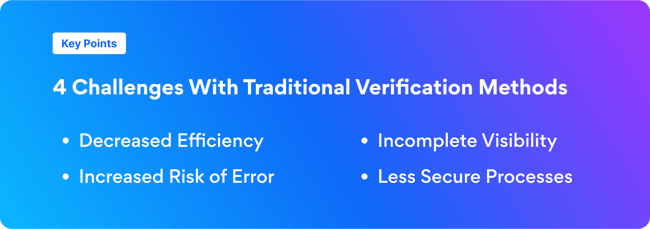
Traditional employment verification methods often involve manual work, such as contacting past employers via phone or email to verify work history.
Here are some of the challenges presented by traditional methods — and why it’s time to update your employment verification tools.
Traditional employee verification methods, such as paper-based forms or manual background checks, are slow and time-consuming. They’re also more difficult to catalog, track, and access on demand.
This can create bottlenecks for HR teams that have to manually verify each employee or search for documents. The result is hiring delays that harm workforce productivity.
Another challenge with traditional verification methods is that they often don’t fulfill 100% of verification requests. Employers are left with gaps in their knowledge, requiring them to spend more time and effort chasing answers by other means.
Manual processes are subject to human errors, which can result in incorrect or incomplete information being collected. This could lead to costly hiring mistakes and missed opportunities.
Moreover, manual processes are difficult to standardize, meaning that not all candidates will be vetted (and treated) in the same way. Inconsistent employee verification can lead to mistakes and even legal risks if there’s a pattern of treating certain candidates differently than others.
Traditional employee verification methods don’t provide enough visibility into the employee’s background and history.
This can make it difficult to spot potential risks, such as a criminal history or expired professional certifications. Even when employers have plenty of candidate information, they can struggle to access it, especially when it’s not digitized.
Traditional employee verification methods are also vulnerable to security risks, such as data breaches and identity theft. This is because these methods don’t use the latest security measures to protect employee data.
Organizations using paper-based processes are also at risk of misplaced, miscategorized, or lost documents.
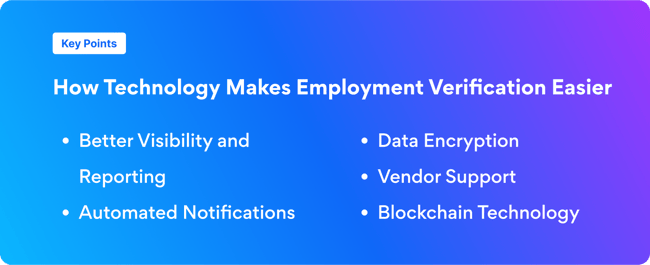
Technology powers employment verification in numerous ways, some of which are visible to candidates themselves. Application programming interfaces make it easy for systems to talk to each other, helping employers make verification inquiries and get results.
Below are some ways background check technology eases your employment background check and verification process.
Look for solutions that offer full visibility into the process and easy-to-understand reporting on the status of each candidate. Employers should be able to access electronic records of employment history, check the status of verification requests, and view completed verifications.
This transparency ensures that verification requests are actively monitored and that needless delays are avoided. Employers receive a clear audit trail of the verification process, making it easier to maintain compliance and address discrepancies promptly.
You can also use review outcomes to assess long-term trends. For instance, you might find that education verification takes the most time. With that knowledge, you can adjust your processes or timelines.
Employers need integrity in their hiring processes, and they also need to move quickly to secure qualified candidates.
Verification technology can automatically nudge HR staff about an individual’s status, alert them if documents are missing, or flag a discrepancy in a background check report. These alerts help employers reduce time to hire and prevent candidates from getting lost in the shuffle.
By encrypting all sensitive employee and candidate information, employers safeguard personal data, such as Social Security and driver’s license numbers. Encryption and other cybersecurity measures also reduce an employer’s risk of liability should a breach occur.
The right verification services technology provider is your partner, ensuring that background checks and other verification processes are accurate, cost-effective, and compliant. Good vendors stay up to date with relevant laws and regulations, helping you avoid potentially costly mistakes and liabilities.
Cisive prioritizes compliance and accuracy with fast results to protect your company and mitigate risks. We offer 24/7, real-time customer support to ensure your company receives solutions any time, anywhere.
Additionally, vendors can handle verification requests for organizations of all sizes. The ability to scale is especially beneficial for larger enterprises or smaller organizations experiencing rapid growth.
Blockchain provides secure storage for verified information, as it can only be accessed by authorized personnel with passwords or keys. This ensures compliance while safeguarding against identity theft or fraud — representing an improvement over traditional methods of verification.
Blockchain technology allows employers to trust information verified securely and eliminates concerns over delays or inaccuracies.
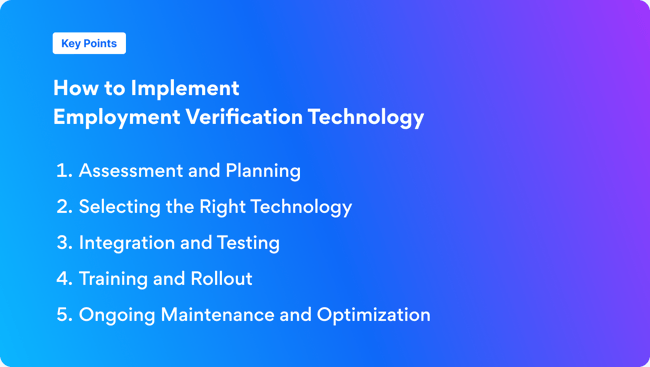
Technology can be a powerful asset in streamlining employment verification, but only when it’s set up correctly and serves the needs of the organization.
From initial planning to integration and ongoing management, learn about implementing employment verification technology.
Assess your current verification processes and identify pain points or inefficiencies.
Define your implementation goals, such as reducing verification time or improving data security. The more specific your reasons for implementing verification technology, the easier it is to assess whether you’ve created better outcomes.
Develop a detailed implementation plan that outlines objectives, timelines, and resource allocation, including who’s responsible for leading each step of the process. Make sure key parties offer input, and share the plan with all affected staff before starting.
Research and choose an employment verification technology solution that aligns with your organization’s needs and goals. Consider factors such as scalability, integration with existing HR systems, security features, and compliance with relevant regulations.
Remember that the best solutions providers do more than sell technology. These software-as-a-service (SaaS) providers also offer additional support.
Cisive, for example, offers a professional reference check service as part of its comprehensive references and verification services.
Integrate the chosen technology into your HR systems and workflow.
Test rigorously to ensure that the technology solution functions correctly, provides accurate results, and aligns with your verification requirements. Address issues or glitches promptly during this phase.
It’s better to take a bit longer to iron out problems than to try and address errors after launch.
Provide comprehensive training to HR personnel and other stakeholders so they can use the verification technology properly and effectively.
Roll out the technology gradually, either through a pilot or through phases. This helps you fix problems early and get all users comfortable with the new system.
Monitor performance throughout while gathering feedback from users.
Implementation is a big step, but you should continue monitoring performance, looking for ways to improve, and assessing the latest advances in employment verification technology and best practices.
Your vendor should offer regular updates, including those that address emerging security threats and regulatory changes. Optimize the technology based on user feedback and evolving organizational needs to ensure long-term success.
One way the blockchain helps employers vet potential hires is the Velocity Network, which is part of the Velocity Network Foundation. This non-profit organization is bridging the gap between employers and candidates by revolutionizing the way career records are shared.
This network makes verification of career data easy and trustworthy — in large part because the data is voluntarily shared by applicants and through the use of blockchain technology.
Here’s how it works.
Accredited issuing organizations issue verifiable career credentials to individuals representing their degrees, licenses, achievements, and work history. In order to do so they must adhere to strict protocols and standards.
Once issued, individuals can accept digital verifiable credentials into a digital wallet, and individuals can authorize organizations to view and verify them.
The Velocity Network makes it easy for you to complete the verification process while giving employees greater ownership over their data.
Cisive is a leader in the background screening and employment compliance industries. We offer a remarkable 99.9994 percent accuracy rate and help our partners achieve an average 31.8 percent reduction in time-to-fill rates.
We work directly with our clients to provide comprehensive and customizable solutions to give your team the power to hire with confidence. Our dedicated support team is available 24/7 to provide additional assistance, answer any question or address any issues.
Employment verification processes are more than administrative tasks. They are a critical component of modern talent acquisition and management.
By leveraging technology to streamline workflows, you improve the accuracy, efficiency, and security of your hiring processes. The result is reduced risk, better hiring outcomes, and a workforce built on trust for employers and employees alike.
In an ever-evolving job market, you need robust employment verification processes to stay ahead of the curve. It’s more important than ever to identify the right talent while complying with data protection and employment regulations.
Schedule a meeting with one of our employment verification experts to learn more about Cisive’s comprehensive suite of education and employment verification services.